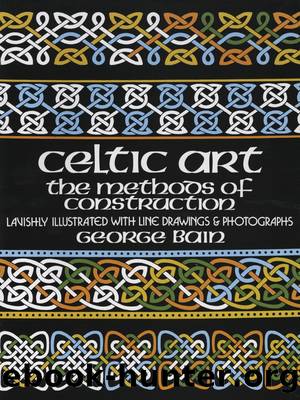Celtic Art by George Bain

Author:George Bain
Language: eng
Format: epub
Publisher: Dover Publications
Published: 2013-06-15T00:00:00+00:00
Plate N
Lettering
THE work of an artist-observer, who has little or no knowledge of ancient languages, may be a very useful aid to research into the written words of Celtic ornamented manuscripts. By a diligent sorting out of the varieties of treatments and the uses of letters, freed from their embellishments, much may be arranged to simplify the work of the language expert. If the artist-observer has in his possession a few examples of the alphabets of the principal ancient languages of the Eastern Mediterranean that preceded the ancient Greek and Latin alphabets, it will not be difficult to find a system of tabulating the results of his works, and if it happens to be in a known language, a language expert will do the rest. A few examples are on Plate 14.
In every publication known to the author that deals with the page of the opening words of the Gospel of St. John in the Book of Kells the language experts have given âIn principio erat verbum et verbum,â which is a wrong reading. Because of their knowledge from other versions of these opening words they were contented with an unfinished sentence as the theme for the decoration of a whole page of the Book of Kells. The Rev. Stanford F. H. Robinson, M.A., gave it up after the first part âIn principio erat verbum,â The artist-observer, with some knowledge of letter shapes, but only the vaguest boyhood Latin, is able to show that the sentence is a complete one and that the letters are âIn principio erat verbum verum.â âIn the beginning was the true word.â
Another interesting example shown on the same plate is the unornamented inscription on the Newton Pillar Stone, Garioch, Aberdeenshire. It is in an unknown language, but most of its letters appear to be similar to Phoenician or Early Greek. It has also an inscription in Ogam letters, and by this it probably resembles the âRosetta Stone.â Unfortunately the Ogam letters are much defaced, and all photographs and drawings examined by the author show that it is extremely difficult to make a correct reading of the Ogam inscription. Shepherds appear to have noticed the inscriptions on it and to have called attention to them in 1803. There have been numerous attempts during the past century, and no two readings have any similarity.
The artist-observer who is unbiassed by a knowledge of ancient languages can sort out the letters to give an interesting and unexpected result connected with the entry of Christianity into North Britain. In the middle of the main inscription the Greek letters for âChrist,â a variation of the monogram X.P.I. probably âChristisâ or âChrestus,â an ancient mutilated spelling, are followed by the Greek letters for âJesusâ I.H.S.S., and then immediately by the Greek word âLOGOU,â âof the word.â
The circumstances of these letters appearing together supports this interpretation even in an unknown language, for such words would undergo little change on entering any language. Following these words, but with less certainty, is either âSot-râ (Soter) Saviour or âPat-râ (Father).
Download
This site does not store any files on its server. We only index and link to content provided by other sites. Please contact the content providers to delete copyright contents if any and email us, we'll remove relevant links or contents immediately.
The Art of Boudoir Photography: How to Create Stunning Photographs of Women by Christa Meola(18543)
Red Sparrow by Jason Matthews(5391)
Harry Potter 02 & The Chamber Of Secrets (Illustrated) by J.K. Rowling(3625)
In a Sunburned Country by Bill Bryson(3486)
Drawing Cutting Edge Anatomy by Christopher Hart(3454)
Figure Drawing for Artists by Steve Huston(3384)
Harry Potter and the Prisoner of Azkaban (Book 3) by J. K. Rowling(3304)
The Daily Stoic by Holiday Ryan & Hanselman Stephen(3235)
Japanese Design by Patricia J. Graham(3112)
The Roots of Romanticism (Second Edition) by Berlin Isaiah Hardy Henry Gray John(2878)
Make Comics Like the Pros by Greg Pak(2856)
Stacked Decks by The Rotenberg Collection(2812)
Draw-A-Saurus by James Silvani(2657)
Harry Potter and the Deathly Hallows (7) by J.K. Rowling(2647)
Tattoo Art by Doralba Picerno(2600)
On Photography by Susan Sontag(2578)
Churchill by Paul Johnson(2510)
The Daily Stoic by Ryan Holiday & Stephen Hanselman(2464)
Drawing and Painting Birds by Tim Wootton(2438)
